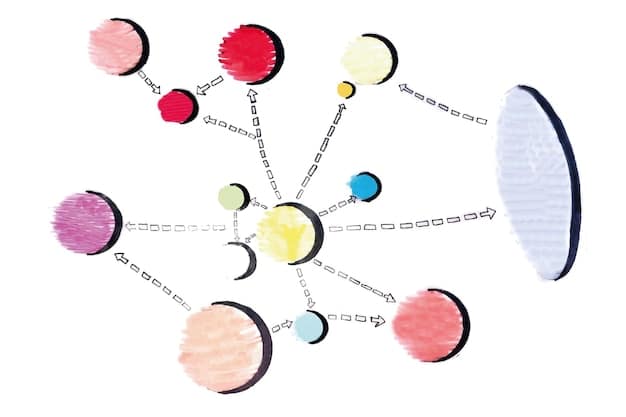Mastering Note-Taking Techniques: Boost Learning by 25%

Mastering note-taking techniques is essential for enhancing learning and retention; effective methods like the Cornell Method, outlining, and mind mapping can significantly improve comprehension and recall, potentially boosting overall learning efficiency by up to 25%.
Unlock your academic potential by discovering effective methods for enhanced learning. Mastering note-taking techniques isn’t just about jotting down words; it’s about transforming information into lasting knowledge.
The Importance of Effective Note-Taking
Taking notes is a fundamental skill, but mastering it separates academic achievers from passive learners. Effective note-taking not only records information but also actively engages the brain, leading to better understanding and retention.
The right techniques can transform lectures and readings into interactive learning experiences, making studying more efficient and improving test scores. In this section, we’ll explore why effective note-taking matters in today’s academic landscape.
Active Learning and Memory Retention
Active learning is a cornerstone of effective education. When you actively engage with course material by taking thoughtful notes, you’re more likely to remember it later. Effective note-taking transforms passive listening into an active mental process.
This active engagement enhances memory retention by creating stronger neural pathways. Consider notes as not just records, but reflections of your understanding and comprehension during the learning process.

Improved Focus and Concentration
Taking notes also helps in maintaining focus and concentration during lectures or readings. When you’re actively trying to summarize and structure information, you’re less likely to get distracted or lose focus.
Improved concentration not only maximizes learning during the initial exposure to the material but also prepares you for future studies and assessments.
- Enhances focus during lectures
- Reduces mental wandering by actively engaging the mind
- Sharpens ability to discern key information
In conclusion, mastering note-taking isn’t just about writing things down, it’s about engaging actively with the material, increasing focus, and reinforcing memory, all critical for academic success.
The Cornell Method: A Structured Approach
The Cornell Method is a highly structured note-taking system designed to enhance organization and recall. This method divides the page into distinct sections, each serving a specific purpose.
By using the Cornell Method, students can systematically organize their notes and reinforce their learning process, making it a valuable tool for effective study and revision.
Setting Up Your Cornell Notes
The Cornell Method involves dividing your note-taking page into three sections: notes, cues, and summary. The notes section is the largest, reserved for capturing the main points during lectures or readings.
The cues section, a narrow column on the left, is for keywords, questions, or prompts to aid recall. The summary section at the bottom is for a brief overview of the main points after the lecture or reading.
How to Effectively Use the Cornell Method
During your lecture or reading, focus on capturing key concepts, examples, and explanations in the notes section. After the session, review your notes and write keywords or questions in the cues column to help you remember the main points.
Finally, summarize the essence of the page in the summary section. This process reinforces the material and makes reviewing more efficient.

- Divide page into notes, cues, and summary sections
- Capture key concepts during lectures or readings
- Review notes and write keywords or questions in the cues column
The Cornell Method provides a structured framework that transforms passive note-taking into an active and engaging learning process, enhancing comprehension and improving long-term retention.
Outlining: Organizing Information Logically
Outlining is a note-taking technique that focuses on structuring information in a hierarchical, logical order. This method helps to organize thoughts and concepts, creating a clear overview of the material.
By using outlines, students can identify the main points, supporting details, and relationships between different ideas, leading to a clearer understanding of the subject matter.
Creating an Effective Outline
To create an effective outline, start with the main topic and then break it down into major points. Under each major point, include supporting details, examples, and sub-points. Use indentation and numbering to show the hierarchical structure.
This technique allows you to see the relationships between different pieces of information and understand how they all fit together.
Benefits of Outlining in Note-Taking
Outlining not only helps in organizing your notes but also aids in understanding the logical flow of the material. It promotes critical thinking by requiring you to identify the most important points and their supporting details.
Additionally, an organized outline makes it easier to review and recall information, which is especially helpful when preparing for exams or writing research papers.
- Start with the main topic and break it down into major points
- Use indentation and numbering to show hierarchy
- Helps in understanding the logical flow of the material
Outlining is an invaluable note-taking technique that aids in organization, comprehension, and recall, enabling students to grasp the essential elements of any subject matter.
Mind Mapping: Visualizing Connections
Mind mapping is a visual note-taking technique that uses diagrams to represent ideas and their relationships. This method can be particularly effective for brainstorming, planning projects, and capturing complex information.
By visually organizing information, mind mapping helps improve understanding and memory retention, making it a powerful tool for visual learners.
How to Create a Mind Map
Start with a central topic in the middle of the page. Then, branch out with major subtopics, connecting each branch to the central topic. Add keywords, images, and colors to represent and link related ideas. Use lines, arrows, and visual cues to show connections and relationships.
This technique allows you to see the big picture while also capturing the details. It also fosters creativity and helps in generating new ideas.
Advantages of Using Mind Maps for Note-Taking
Mind mapping encourages creative thinking and helps in making connections between different pieces of information. It promotes a holistic understanding of the subject matter and aids in memory recall.
This method is especially useful for subjects that require integrating multiple ideas, such as history, literature, or interdisciplinary studies.
- Start with a central topic
- Branch out with major subtopics
- Add keywords, images, and colors to link ideas
Mind mapping is an innovative note-taking method that uses visual organization to enhance comprehension and memory, helping students make meaningful connections and foster creativity.
Digital Note-Taking Tools and Apps
In today’s digital age, numerous tools and apps are available to enhance the note-taking experience. These digital solutions offer various features, from cloud syncing to multimedia integration, making note-taking more efficient and versatile.
By leveraging digital note-taking tools, students can streamline their learning processes, organize their information effectively, and collaborate with peers effortlessly.
Popular Note-Taking Apps
Some popular note-taking apps include Evernote, OneNote, and Google Keep. Evernote provides robust organization features and allows you to clip web articles and integrate audio recordings. OneNote, part of the Microsoft Office suite, offers seamless integration with other Microsoft tools and supports collaborative note-taking.
Google Keep is a simple, user-friendly option that’s great for quick notes and reminders. These apps often offer features like tagging, search, and cross-platform syncing, ensuring your notes are always accessible and organized.
Benefits of Digital Note-Taking
Digital note-taking offers numerous advantages, including the ability to easily edit, organize, and share notes. You can also integrate multimedia elements, such as images, audio recordings, and videos, to create richer and more engaging notes.
Furthermore, digital tools often provide search capabilities, making it easy to find specific information within your notes. Cloud syncing ensures that your notes are backed up and accessible from any device.
- Evernote, OneNote, and Google Keep are popular options
- Easily edit, organize, and share notes
- Integrate images, audio, and video
Digital note-taking tools offer a myriad of benefits, from enhanced organization to multimedia integration, making them indispensable resources for students seeking to optimize their learning experiences.
Tips for Maximizing Learning and Retention
Effective note-taking is more than just writing things down; it’s a process that supports deeper understanding and better retention. By implementing specific strategies, you can maximize the effectiveness of your note-taking and enhance overall learning.
These advanced tips will guide you through the practices that successful learners use to make the most of their notes and study sessions.
Reviewing and Revising Notes Regularly
One of the most effective ways to improve retention is to review your notes regularly. Reviewing shortly after taking them helps reinforce the information in your memory. Regular review allows you to fill in any gaps and clarify points you may have missed during the lecture or reading.
Revision, on the other hand, involves editing and reorganizing your notes to improve clarity and structure. Revising your notes transforms them from a raw record of information into a refined study aid.
Connecting Notes to Prior Knowledge
Connecting new information to what you already know can significantly enhance understanding and retention. When taking notes, try to link new concepts to your existing knowledge base.
This process helps create a more meaningful and memorable learning experience, as it solidifies the mental connections between ideas. Drawing parallels or finding relationships between new and familiar concepts makes new information more relatable and easier to remember.
- Review notes shortly after taking them
- Revise notes to improve clarity and structure
- Connect new information to existing knowledge
By reviewing, revising, and connecting notes to prior knowledge, you can supercharge your learning and retention, ensuring that your efforts translate into academic success.
| Key Point | Brief Description |
|---|---|
| ✍️ Cornell Method | Structured approach with notes, cues, and summary sections. |
| 🌳 Outlining | Organizes information in a logical, hierarchical order. |
| 🧠 Mind Mapping | Visualizes connections between ideas using diagrams. |
| 💻 Digital Tools | Apps like Evernote, OneNote, and Google Keep enhance note-taking. |
Frequently Asked Questions
▼
The Cornell Method divides your page into notes, cues, and summary sections. During lectures, capture key points in the notes section, then write cues to aid recall, and summarize the main points to reinforce your learning.
▼
Outlining enhances note-taking by structuring information in a logical order. It helps you identify main points, supporting details, and the relationships between ideas, leading to a clearer understanding.
▼
Mind maps visually organize information, making it easier to understand and remember. They encourage creative thinking and help you see connections between different pieces of information more effectively.
▼
Popular digital note-taking apps include Evernote, OneNote, and Google Keep. These tools offer organization, multimedia integration, and cross-platform syncing, ensuring your notes are always accessible and well-managed.
▼
To maximize learning, review and revise your notes regularly. Also, connect new information to your prior knowledge to enhance understanding and retention, making the learning process more meaningful.
Conclusion
Mastering note-taking techniques offers a transformative path to enhanced learning and retention. By adopting structured methods like the Cornell Method, outlining, and mind mapping, and by leveraging digital tools, students can significantly improve their comprehension and recall. Regular review and revision, along with connecting new knowledge to existing insights, are essential for maximizing the benefits of effective note-taking and achieving academic success. Embrace these strategies to unlock your full academic potential.





